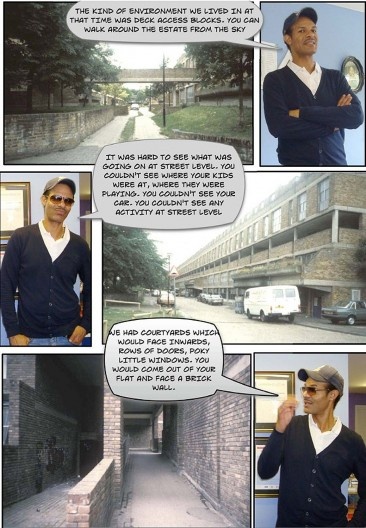
Comic with images and perceptions extracted from a video made by children at Angell Town
Illustration by Regina Lim
Paula Barros: If it is accepted that “aesthetic reaction is an indication of an environment where effective human functioning is likely to occur” (15) it may be argued that the aesthetic quality of urban experience, which is necessarily multisensory, is an issue which matters not only to urban designers, planners, landscape architects, architects and policy makers, but also to the general public. How to foster effective participation in design decisions, frequently based on the practitioners” own preferences, if there are competing parameters to define urban aesthetic quality?
Ian Bentley: From my own experience of working with community groups, I think that different aesthetic parameters are less of a problem than the difficulty most designers find in structuring an open debate about aesthetic issues. Without this, it is impossible to move towards finding aesthetic common ground, or even to construct a civilised agreement to differ. To engender a debate (rather than just a big row) designers have to be able to explain – not just describe – the reasons for their aesthetic proposals.
We therefore have to get far better than most of us (including me!) currently are at communicating beyond limited professional audiences. I think MVRDV”s ideas about “information art” (for example in their Datatown book), and the design rationales produced by the New York firm REX, or even the “graphic novel” that Bjarke Ingels recently produced, all suggest creative ways forward; in format if not in detailed content. At Angell Town, our colleague Regina Lim used images and verbal comment from a video made by children to create a very communicative comic.
The current global insistence (very powerful in the UK) that creative young thinkers in universities must go in the opposite direction – gaining promotion through writing in specialist journals, refereed by specialist peers, that only other specialists will ever read – seems to me symptomatic of a debilitating cultural implosion that is the opposite of participatory. Even – or perhaps especially – when they write papers about participation.
note
15
KAPLAN, Rachel, KAPLAN, Stephen and RYAN, Robert. L. With people in mind: design and management of everyday nature. Washington D.C: Island Press, 1998, p. 57.



